Difference Between Cilia and Flagella
Cilia and flagella can be described as complex cellular structures present in living organisms and are involved in the locomotion of the organism and movement of fluids and in sensory functions too. Cilia and flagella are topics of the chapter Cell: The Unit of Life in Biology.
What are Cilia and Flagella?
Cilia and Flagella are slender and are made of microtubules nevertheless, they possess different functions and properties. Ependymal cilia are shorter and present in large numbers; they are involved in mechanisms such as the clearance of mucus in the respiratory system and signal elimination in sensory organs. Compared to them, flagella are longer, though fewer in number. Most of the structures in the cell shapes of the known microorganisms, which are mainly characterised by ciliary and flagellar beats, aid cell propulsion by undergoing rotational or wave-like motions.
- What are Cilia and Flagella?
- Structure of Cilia and Flagella
- Types and Classification
- Function and Mechanism of Action
- Key Differences Between Cilia and Flagella
- Similarities Between Cilia and Flagella
- Diseases and Disorders Related to Cilia and Flagella
- Recommended video for Cilia and Flagella
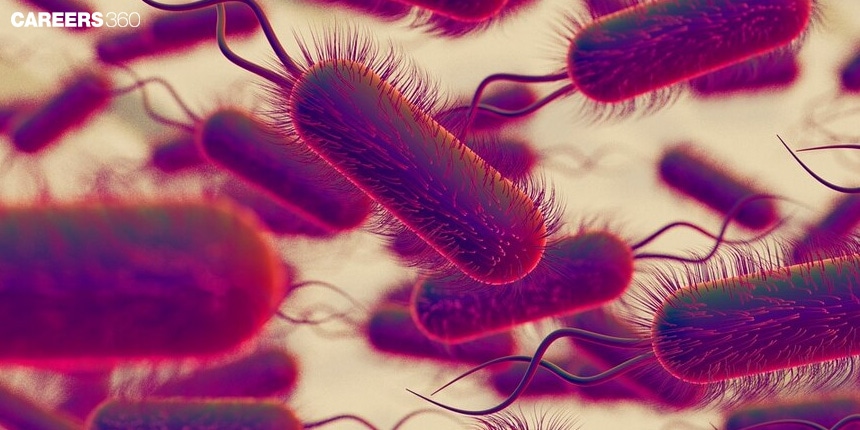
Structure of Cilia and Flagella
The structure of cilia and flagella is given below-
Cilia
Structure:
Cilia are slender, tubular extensions from the cell membrane or surface of the cell. They are usually abundant on the cell membrane and have been noted to be essential components of the cell membrane.
Arrangement:
Cilia have a basic structural component called the axoneme which is composed of nine peripheral microtubule doublets and a central pair of microtubules.
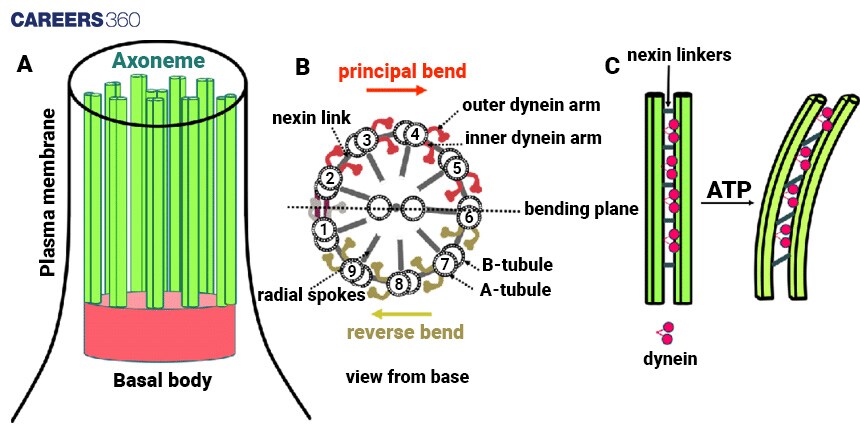
Flagella
Structure:
It is longer, thinner, and fewer than cilia; it has the movement of a whip. These come out of the cell surface and are concerned with cell movement.
Arrangement:
Just as it is in cilia, eukaryotic flagella possess a ‘9+2’ organization of microtubules in which nine outer doublets surround two central microtubules.
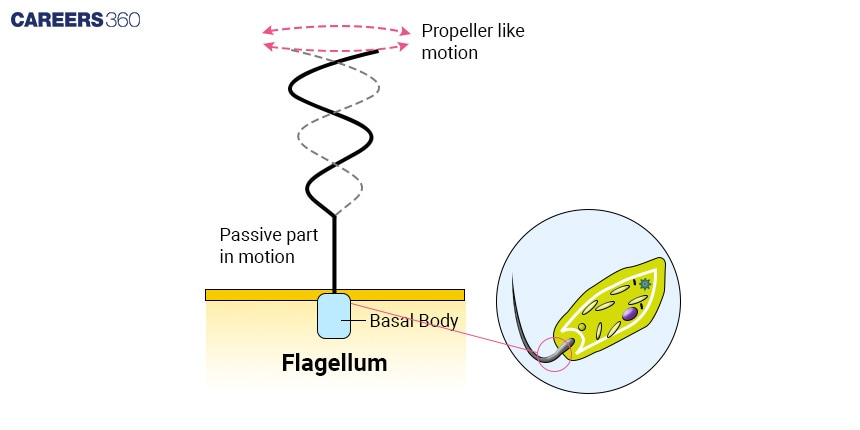
Also Read-
Types and Classification
Cilia can be classified into:-
Cilia
Motile Cilia
Function: Motile cilia are involved in the movement and flow of fluids and therefore have crucial functions like mucus removal in the respiratory system, and movement of the eggs in the fallopian tubes.
Examples: Identified in the respiratory tract’s epithelial cells and the epithelium of the female reproductive system.
Non-motile Cilia
Function: Structural cilia mainly function as tabs that help in perceiving signals in the environment and transmitting them into the cell.
Examples: Located on olfactory neurons located in the nose and photoreceptor cells of the retina.
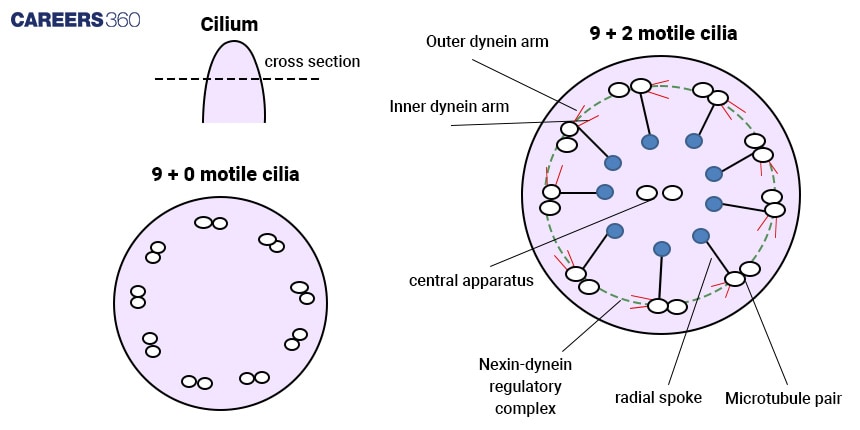
Flagella
Given are the structure and function of flagella-
Prokaryotic Flagella
Structure: Flagella found in prokaryotic organisms are small structures made up of flagellin and are mainly involved in movement.
Movement: Rotational movement occurs with bacteria even as they propel themselves through the water as they search for nutrients.
Examples: Usually found in bacteria like E. coli and Salmonella
Eukaryotic Flagella
Structure: The eukaryotic flagella are elaborate structures that are made up of microtubules in the “9+2” formation.
Movement: They come in a sinusoidal pattern so that they help in the propulsion and the movement of the cell.
Examples: Present in sperms for movement, and some of the protozoa for their means of movement.
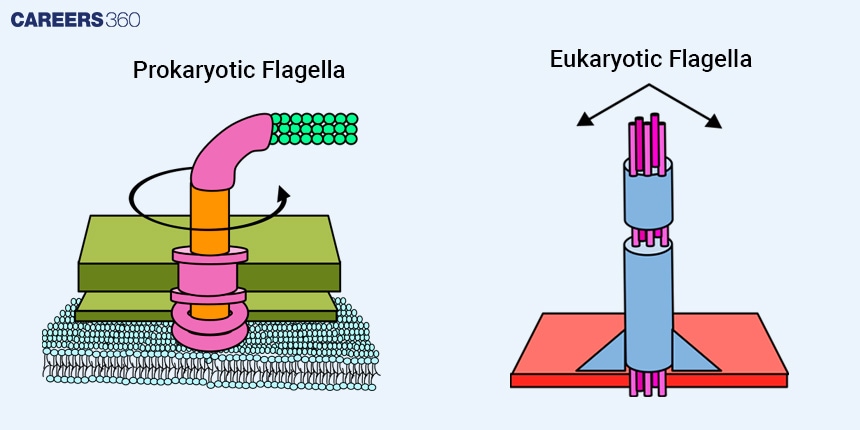
Function and Mechanism of Action
Following describe the function and mechanism of cilia and flagella-
Cilia
Movement and locomotion:
Cilia enable the movement and locomotion of several organisms ranging from single-celled; protists such as Paramecium to complex organisms which include; humans. In the animal Paramecium, the coordinated coordination of cilia is vital for the movement through water, in the respiratory tract the ciliary movement is very important in the removal of mucus and other materials.
Sensory functions:
Cilia are also involved in sensory functions to the environment to receive signals as well as translate these signals to the cell. It is noted that in the human body, primary cilia take part in the transduction of various signals which includes the sensory processes of kidneys and eyes.
Flagella
Locomotion and propelling cells:
While flagella are mostly involved in cell movement and navigation it has to be understood that the primary purpose of flagella is to allow an organism to move within its environment. In bacteria, moving by swimming and orienting in the space is facilitated by the flagella while in sperm cells, it moves the cell towards the egg during reproduction.
Sensory functions:
Like cilia, flagella occasionally have some sort of sensation function to feel changes in the surroundings and affect corresponding behavioural reactions. For instance, the bacterial flagella have chemotactic properties; this means that bacteria can feel chemical differences and can move in the direction of such differences to locate the best conditions.
Key Differences Between Cilia and Flagella
The following summarises the structural and functional differences between cilia and flagella.
Aspect | Cilia | Flagella |
Structure | Shorter, numerous, "9+2" arrangement of microtubules | Longer, fewer, "9+2" arrangement of microtubules |
Present in large numbers on the cell surface | Typically fewer in number | |
Primarily involved in locomotion and fluid movement | Mostly sensory roles | |
Function | Facilitate movement, fluid flow, and sensory perception | Enable cell propulsion and sensory functions |
Found in the respiratory tract, reproductive system, and sensory organs | Found in bacteria, sperm cells, and certain protists | |
Movement Mechanism | Coordinated beating pattern | Wave-like undulation or rotational movement |
Generates fluid movement or propels cells | Propels cells through a fluid medium |
Similarities Between Cilia and Flagella
The following summarises the similarities between cilia and flagella.
Aspect | Cilia | Flagella |
Shared Structural Components | Both are composed of microtubules and associated proteins | Microtubule-based structures with dynein arms |
Common Origin | Evolved from ancestral motility structures | Shared evolutionary pathways |
| Functional resemblance | Are used to move liquid across the cells. | They also help to move liquids past the cells. |
Diseases and Disorders Related to Cilia and Flagella
The diseases and disorders are explained below-
Ciliary Disorders
Primary ciliary dyskinesia: PCD is an inherited disease that is associated with a failure of ciliary motility resulting in repeated respiratory infections, sinus, bronchiectasis, and problems in conception.
Kartagener syndrome: Specifically, it is also called primary ciliary dyskinesia with situs inversus, and is featured by chronic respiratory infections, sinusitis, bronchiectasis, and inversion of the heart and liver.
Flagellar Disorders
Impact on fertility: Mutations in flagella in sperm can be a cause of male infertility due to the problems associated with the motility of sperm found in semen to subsequently fertilize the egg.
Bacterial infections: Flagella are involved in the pathogenesis and virulence of different bacteria, including Salmonella, and Pseudomonas aeruginosa because they facilitate the organisms’ invasion of host tissues and the development of infections.
Also Read-
Recommended video for Cilia and Flagella
Frequently Asked Questions (FAQs)
Cilia are present in large numbers but are shorter structures, whereas flagella are fewer and longer, whip-like structures. Cilia typically have a 9+2 microtubular structure, while in flagella they may be 9+2 or 9+0 in some cases. Cilia- are involved in movement and sensory functions whereas flagella- are mainly involved in the propulsion of cells in a fluid environment.
Cilia are involved in moving, fluids, and sensory, and can be seen as important in functions such as mucus removal in humans and the movement of eggs within the female reproductive tract in animals. It mainly plays the role of propelling cells and thus the sperm cells can move towards the egg during the process of fertilization and some of the members of the kingdom Protista.
Cilia and flagella are structurally made of microtubules in the pattern of “9+2”, which this composed of nine doublets of microtubules surrounding two microtubules in the center. These also consist of motor proteins such as dynein arms that are involved in a movement-producing manner. Nevertheless, cilia are far shorter than the flagella and many can be seen at a glance whereas flagella are relatively longer and few are seen.
Some organisms with cilia are paramecium, a kind of protozoa that uses cilia for movement, and cells in the human respiratory tract for moving the mucus. Some examples of organisms with flagella are sperms who use them in swimming to the egg and Euglena one of the protists that uses flagella in moving.
Genetic disorders that affect cilia structure and their ability to move are primary ciliary dyskinesia or PCD and Kartagener syndrome. Problems with the flagella in sperms can result in male sterility, conversely, the flagellar motility assists pathogenic bacteria to infect their host resulting in diseases such as bacterial gastro-enteritis.
Also Read
02 Jul'25 07:36 PM
02 Jul'25 07:30 PM
02 Jul'25 05:57 PM
02 Jul'25 05:57 PM
02 Jul'25 05:57 PM
02 Jul'25 05:57 PM
02 Jul'25 05:57 PM
02 Jul'25 05:54 PM
02 Jul'25 05:54 PM
02 Jul'25 05:54 PM